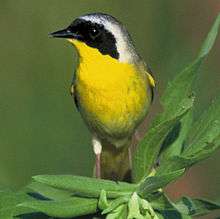Yellowthroat
| Yellowthroats | |
|---|---|
 | |
| Male common yellowthroat | |
| Scientific classification | |
| Kingdom: | Animalia |
| Phylum: | Chordata |
| Class: | Aves |
| Order: | Passeriformes |
| Family: | Parulidae |
| Genus: | Geothlypis Cabanis, 1847 |
| Species | |
|
See text. | |

The yellowthroats are New World warblers in the genus Geothlypis. Most members of the group have localised ranges in Mexico and Central America, but the masked yellowthroat has an extensive South American distribution, and common yellowthroat, the only migratory species in the group, breeds over much of North America.
All the yellowthroats have similar plumage, with yellow-green upperparts, yellow breast, and a mainly black bill. The adult male has a black facemask of variable extent, usually bordered above with a grey band. The female is similar, but lacks the black mask, and may be duller in plumage.
The breeding habitat of these warblers is typically marshes and other wet areas with dense low vegetation. The eggs, two in most species, but up to five for common yellowthroat, are laid in a lined cup nest low in grass or rank vegetation.
Yellowthroat are usually seen in pairs, and do not associate with other species. They are often skulking, and feed on a range of insects.
The taxonomy of these closely related species is complicated, and it is sometimes difficult to define which forms merit species status. For example common yellowthroat, Belding's yellowthroat, Altamira yellowthroat, and Bahama yellowthroat are sometimes considered conspecific. Conversely masked yellowthroat can be split to three or even four species.
The geographical isolation of the various populations of this mainly sedentary group has led to its genetic divergence and speciation. This process can be seen in action in the case of masked yellowthroat, where the subspecies are separated by rainforest or the Andes, leading to the development of distinctive forms, such as the Central American race Geothlypis aequinoctialis chiriquensis. This form is found in the highlands of Costa Rica and western Panama, and is separated by 1000 km from its South American cousins, from which it differs in size, appearance and vocalisations.
To further confuse this group, the Kentucky warbler, mourning warbler, and MacGillivray's warbler have been added to this group.
Species
- Common yellowthroat, Geothlypis trichas
- Belding's yellowthroat, Geothlypis beldingi
- Altamira yellowthroat, Geothlypis flavovelata
- Bahama yellowthroat, Geothlypis rostrata
- New Providence yellowthroat, Geothlypis rostrata rostrata (extinct: 1990s?)
- Olive-crowned yellowthroat, Geothlypis semiflava
- Black-polled yellowthroat, Geothlypis speciosa
- Masked yellowthroat, Geothlypis aequinoctialis
- Southern yellowthroat, Geothlypis (aequinoctialis) velata
- Black-lored yellowthroat, Geothlypis (aequinoctialis) auriculata
- Chiriqui yellowthroat, Geothlypis (aequinoctialis) chiriquensis
- Gray-crowned yellowthroat, Geothlypis poliocephala
- Hooded yellowthroat, Geothlypis nelsoni
- MacGillivray's warbler, Geothlypis tolmiei
- Mourning warbler, Geothlypis philadelphia
- Kentucky warbler, Geothlypis formosa
References
- Curson, Quinn and Beadle, New World Warblers ISBN 0-7136-3932-6
- ffrench, Richard (1991). A Guide to the Birds of Trinidad and Tobago (2nd ed.). Comstock Publishing. ISBN 0-8014-9792-2.
- Hilty, Birds of Venezuela ISBN 0-7136-6418-5
- Stiles and Skutch, A guide to the birds of Costa Rica ISBN 0-8014-9600-4